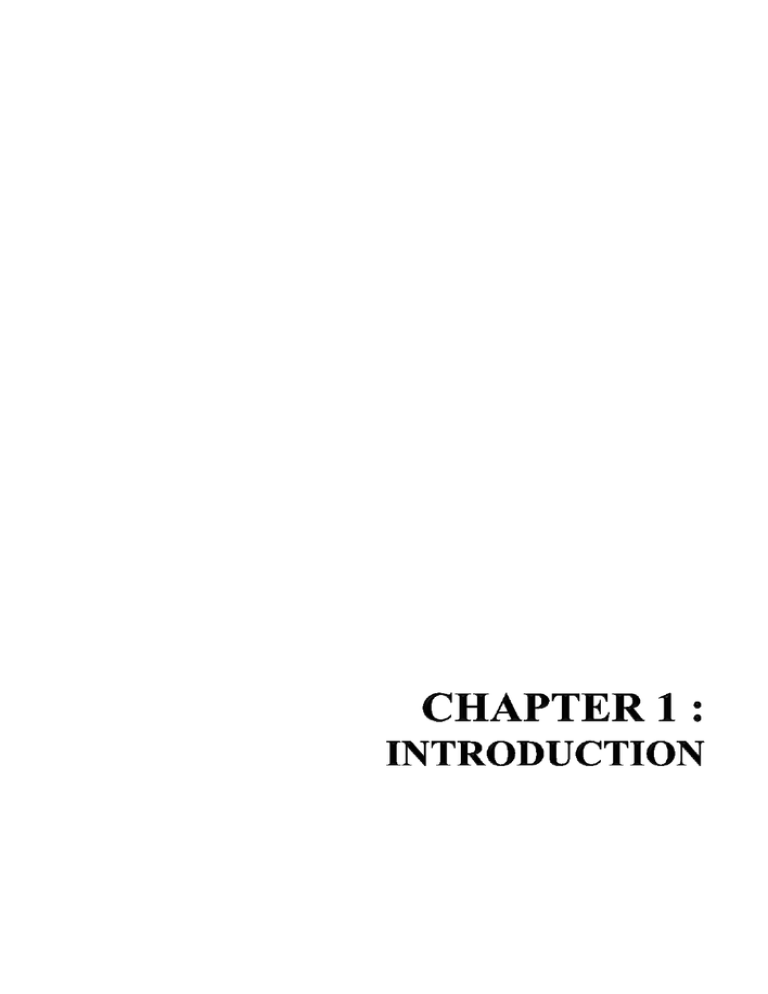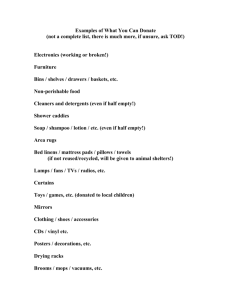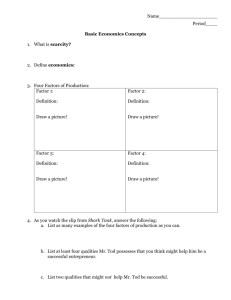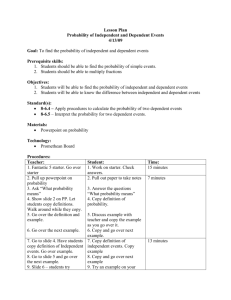Document 14602208
advertisement

1 CHAPTER 1 1 INTRODUCTION The current rapid development activities have resulted in the increase of the needs and dependencies on motor vehicles. Uncontrolled development and urban sprawl have caused the ineffectiveness of the public transportation systems. It is a relation between land use and the fundamentals in transportation. They interact and relate to many other issues that are important to the communities (Hanson, 1995). For example, this development has resulted in urban problems such as traffic congestion, lack of affordable housing provision due to the rising costs of living and air pollution. These entire urban problems have decreased the quality of life in urban areas. For example, the current development in Johor Bahru City has been growing by 5.52 per cent per year in the past 20 years. This has multiplied by more than three times from 10 thousand hectares in 1980 to 32 thousand hectares in 2000. (TCPD: Johor Structure Plan, 2000) This involves the development of an area within the 15 kilometre radius to a 30 kilometre radius from the town centre. Uncontrolled urban sprawl development has resulted in the increase of traffic flow on major roads leading to the town centre. Nowadays, TOD has gained popularity as a means of redressing a number of urban problems, including traffic congestions, shortage in affordable housing, air pollution and incessant sprawl. (Cervero, Ferrel and Murphy, 2002). TOD is also a part of the sustainable development process. 2 TOD generally has a finite size of about 200 hectares, which is often diagrammatically represented by an area of 800 meter radius around the transit station. This may be considered as the board ‘walk able catchment’ which is the equivalent to about 10 minutes-walk from the transit station to the edge of the development area (R. Falconer and E. Richardson, 2010). TOD is a part of land development concept known as “Smart Growth” and “New Urbanism”, This study is about looking at the requirements of the appropriate type of land use with a suitable density to ensure that TOD can be properly planned and developed. This study will be based on Greenfield development in Nusajaya, Johor to compare with the other existing successful TOD in Malaysia. At the end of this, the study will propose the minimum outline of appropriate land use criteria for TOD development The rapid growth in the development of the automotive industry in Malaysia has increased the motor vehicle ownership. According to the Ministry of Transport, statistics show that by the year of 2010, 21.2 million vehicles were registered. This has been increasing from year to year. In the year 2009, the number has increased by 11.7 percent and in 2010, it has increased by 13.7 percent. The growth rate is higher than the population average growth rate of 2.7 percent per year. Based on this scenario, it is estimated that the number of registered vehicles will increase to 50 million by the year 2020. (Department of Statistics Malaysia 2006). 3 Note: a = actual, e= estimated Source: Abidin et al. (2004) and Department of Statistics Malaysia (2006) Figure 1.1 : Vehicle Growth This increase in car ownership has also been caused by the incentives offered by banking institutions, such as low interest rates of between 2.5 to 5 percent per annum and 100 percent loan facility. This has made an average of 3 private vehicles per household if compared to the current registered vehicle population. The number of households is 6.3 million. Urban sprawl refers to the outgrowth of urban areas caused by uncontrolled, uncoordinated and unplanned urban growth. The inability to visualize such growth during planning, policies and decision making process has resulted in sprawl that is both unsustainable and inefficient. (M. Rafee Majid & Hafizul Yahya). Urban sprawl will pose a problem to provide a centralized infrastructure development. Bigger development area would require a bigger allocation for infrastructure development. Urban sprawl would also cause difficulty for public transportation service to provide comprehensive services. This would cause ineffectiveness of the public transportation service to serve the overall area. 4 In major cities in Malaysia, for example; most of the people travel more than 45 minutes to the work place by choosing to live in the suburban areas. In Kuala Lumpur for instance, urban sprawl has been out of control, where development has been scattered up to 60 kilometre radius. As well as Johor Bahru, the development has sprawled to more than 30 kilometres radius. Urban limit or urban growth boundary is the solution to advocating morecompact development for a city, but it is not going to curb its sprawl. Clear planning policies and sequential approach method need to be implemented to control development activities. Incentive and other facilities also need to be provided to the developer to encourage compact and smart growth development. Government through the 10th Malaysian Plan (10thMP) has put emphasis on smart growth and compact city concept. In chapter 6: Building an environment that enhances quality of life, the 10thMP; the Government is committed to ensure a high quality life in urban and rural areas in line with Malaysia’s aspiration to become a developed nation. To achieve this aspiration in enhancing the quality of life, related strategy had been outlined such as: a. Building vibrant and attractive living spaces. Influencing the form and character of living spaces to make them attractive places to live, work and play; b. Developing a people-centric public transport system. Restructuring the public transport sector and continuing to invest in infrastructure to make public transport the mode of choice; c. Making streets and communities safer. Reducing crime and improving people’s sense of security. From this outline strategy, it is expected that over 70 percent of Malaysia’s population will reside in the urban areas by the year 2020. Therefore, emphasizing on making well-being, quality of life and liveability is the core of any urban project and the important factor in designing a new city centre. Mixed use concept to encourage living, working and leisure activities in the same areas can reduce trip generation. 5 1.1 Problem Statement TOD concept is a new development approach in Malaysia. Currently, there is no specific transit oriented development guideline in Malaysia. Some developers claimed that their development is transit friendly and in compliance with the TOD standard. However, how far does this development project fulfil the TOD standard and criteria?. Nusajaya, being a newly developed area, is planned to be a transit oriented city. This study will assess the TOD standard and criteria for Nusajaya development to determine how far do its current and future developments comply with the standard and criteria. 1.2 Research Goal and Objectives a) Study Goal The goal of this study is to assess the current and future land use development of Nusajaya, Johor in compliance with the TOD standard and criteria. b) Study Aim The aim of this study is to assess the transit oriented development standard and criteria based on the current and future land use development. c) Study Objective To achieve this goal, four (4) main objectives have been outlined in this study. Several input and findings can be discovered from the study. i. To understand the standard and criteria of TOD concept in assessing the TOD development; ii. To formulate the assessment indicator for TOD planning; iii. To assess current and future land use development component of the study area; and iv. To propose and advocate the mitigation measure for future improvement in Nusajaya. 6 1.3 Research Questions There are three questions identified to achieve the objectives outlined i. What are the standard and criteria of TOD? ii. What are the suitable TOD standard and criteria to be implemented in the study area? iii. 1.4 Does the study area fulfil the concept of transit oriented development? Scope of Research The study will focus on the following aspect: i. The study area only consists of the Flagship B (Nusajaya), Iskandar Malaysia ii. The study will assess on current and future land use development planning based on TOD standard and criteria. iii. The study will be based on secondary data on the existing development plan of Nusajaya, Iskandar Malaysia. iv. The study will only assess current and future development plan until the year 2020. 1.5 Research Assumptions The main source of information for this study is based on existing and proposed land use. This study also refers to the government proposal for a public transportation master plan in the study area. Hence, this study will be conducted under the assumption that there is no change in the pattern of significant land use. The research also presumes that there is no change in the current policy and public transportation master plan for the study area. 7 1.6 Limitations of Research This study will be based only on the current and future land use planning until the year 2020. Land use is the most important element in determining the success of the TOD. Inventory of land use will cover an area of 2 km radius from the transit centre where it covers the pedestrian zone and feeder bus service zone. This study will focus on the development of Flagship B (Nusajaya) of Iskandar Malaysia, Johor. The analysis of land use and projected demand and need is based on the proposed land uses planned. Nusajaya is a new development area which has not been proven to be on the level of success with respect to the implementation of TOD. Assumptions and projections based on land use plan is used as a model to calculate the demand requirements. The study will not cover any other detailed technical designs such as the type of trees and materials to be used in the construction. This study will also not take into consideration the number of passengers for existing public transportation users and their efficiencies. 1.7 Expected Contributions At the end of this research, we will identify the level of achievement in the implementation of the TOD concept. The study also will propose the suitable TOD standard and criteria to incorporate with the proposed land use planning. 1.8 Significance of Research The aim of the research is to assess the achievement of the Nusajaya development in complying with the TOD standard and criteria based on their current and future land use planning. This research will reveal the standard and criteria to be attained in order to support transit oriented development implementation. The initiative for this study is find the best way that can support a number of factors including: 8 i. Identifying the suitable land use proponents for the TOD concept in Malaysia; ii. Increasing the public transportation ridership especially in the new development area; iii. As a planning guidance to the planner, developer and government agency. 1.9 Research Design This study will be conducted in four steps: i. Research Issue Formulating the research issue, objective and hypothesis is to ensure the research in the pipeline. ii. Literature review This study will be supported with an extensive literature in a related topic pertaining to the TOD concept. The source of the literature will be in the form of journals, reports, books, paper works and others. In this literature review, focus will also be put on case studies and lessons learnt from the other successful TOD in the region. Beside the TOD, literature also will include the study of the land use development concept and approach such as smart growth concept, new urbanism and sequential approach. iii. Data collections and analysis Secondary data will be mainly used in this study. The proposed land use planning by the developer and planning authority together with the public transportation planning to propose for the study area will be analysed. Primary data in the form of site observations and oral interviews will be used to support the secondary data. 9 iv. Findings At the end of the study, conclusion and finding will be formulated based on data analysis to support the hypothesis. Standard planning guidance will be proposed as a guide to the developer and the authority to get the suitable land use proponents for the TOD implementation. 1.10 Thesis Outlines This thesis will be written in five chapters: i. Chapter 1 : Introduction This chapter will address the underlying research background, problem statement, scope of study and limitation. ii. Chapter 2 : Literature Review This chapter will review the empirical studies of the reports, journals, books and other sources related to the TOD and land use development. iii. Chapter 3 : Research Methodology This chapter will outline a step by step process of the research from the formulation of the issue, data collections, analytical method and findings. iv. Chapter 4 : Analysis and Findings This chapter will provide the result of analysis including maps, sketches and graphics showing the existing and proposed land use proponents based on the data collected. Land use characteristics and TOD concept will be tested based on outlined hypothesis. v. Chapter 5 : Recommendations Based on analysis done in the earlier chapter, recommendations and proposals on the planning guidance for the land use availability for 10 TOD concept will be formulated. Potential for further study and limitation of this study will also be proposed. 1.11 Summary As a whole, this chapter has described the overall research flow together with the aim and expected findings at the end of the research. The issue described earlier as a guide to the researcher to find the answer based on the outlined objectives and research questions. In the next chapter, researchers will describe in detail about the existing and the theories of TOD and compare with the land use concept and approach.



